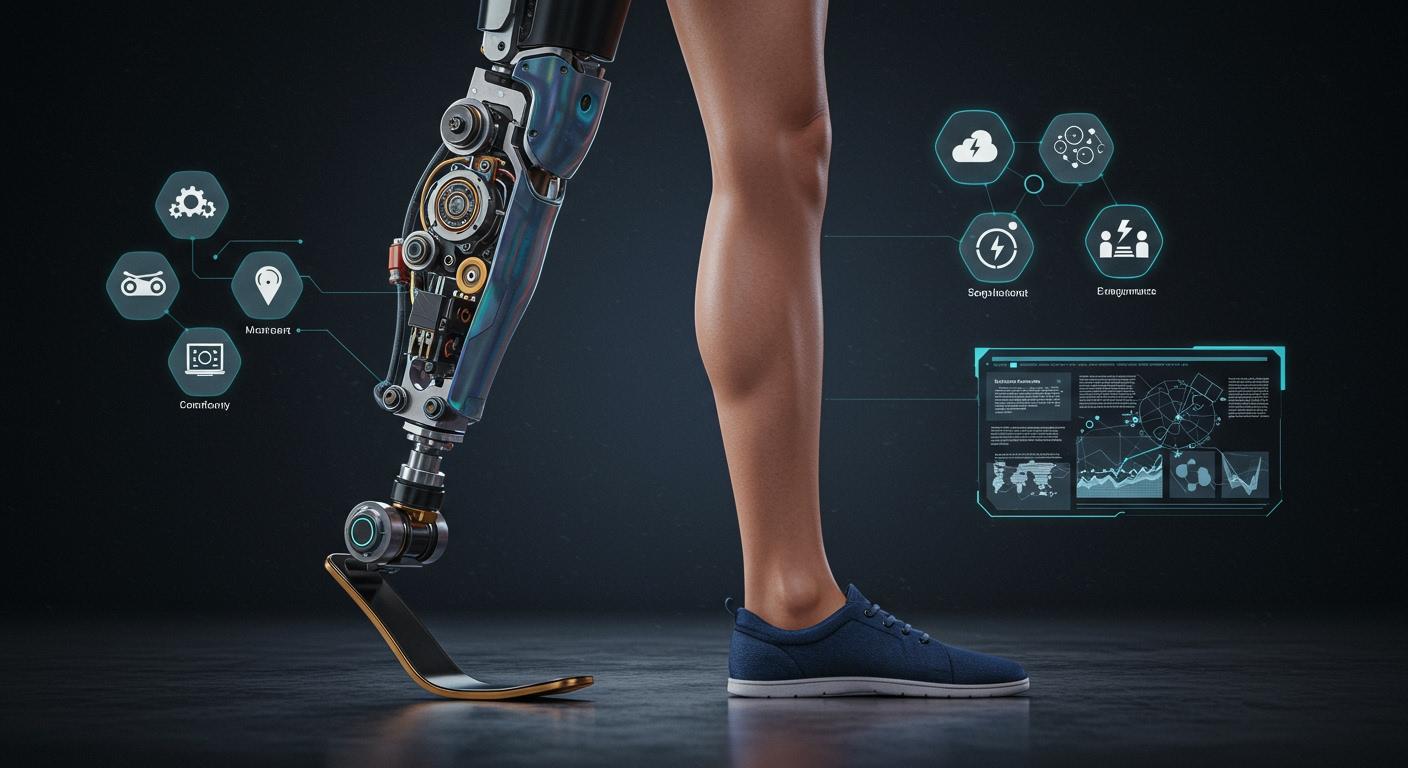How space station motors improve robotic prosthetic leg comfort and battery life
Imagine starting your day with a robotic prosthetic leg that feels lighter and moves more naturally. Many users say heavy weight, large size, and short battery life make daily tasks harder. Now, you can experience smoother movement, less fatigue, and longer use between charges thanks to motors designed for space stations.
| Challenge/Feature | Description |
|---|---|
| Weight | Existing powered prostheses are much heavier than conventional passive prostheses. |
| Size | Robotic prostheses are larger, impacting their usability in daily life. |
| Battery Life | Shorter battery life compared to conventional prostheses limits their clinical viability. |
These new motors help you walk with less effort and enjoy more freedom every day.
Key Takeaways
- Space station motors make robotic prosthetic legs lighter and more efficient, allowing for smoother movement and less fatigue.
- The advanced design of these prosthetics reduces noise and energy consumption, enabling longer use between charges.
- Users can personalize their walking experience, leading to improved comfort and stability throughout daily activities.
- Regenerative braking technology captures energy during walking, extending battery life and enhancing overall efficiency.
- Many users report increased confidence and independence, allowing them to engage more fully in social and physical activities.
Space station motor technology

Free-swinging knee motion
Motors designed for space stations now help you move with greater ease. Engineers adapted these motors for robotic prosthetic legs by making them lightweight and efficient. You benefit from joints that feel more natural and flexible. When you walk, your knee can swing freely, much like a biological joint. This flexibility means you experience less resistance and more comfort with every step.
“We designed our joints to be as compliant, or flexible, as possible,” states Toby Elery, first author of the study and recent doctoral graduate from UT Dallas. “Our robotic leg can perform and even react like a human joint would, enabling a naturally free-swinging knee and shock absorption when contacting the ground.”
You will notice that the motor in your prosthetic leg allows for smoother movement. The design reduces stiffness and absorbs shock when your foot hits the ground. This makes walking less tiring and helps you feel more confident on different surfaces. By using fewer gears, the motor also cuts down on weight and makes each step feel lighter.
Streamlined and quiet design
A streamlined and quiet design improves your daily experience. The new robotic prosthetic leg uses advanced small motors and fewer gears. This approach makes the device quieter and more energy-efficient. You can walk in public spaces without drawing attention to mechanical noises.
- The new robotic prosthetic leg prototype offers a more natural gait, which enhances user comfort.
- It is quieter and more energy-efficient than previous designs, reducing noise levels significantly.
- The use of advanced small motors and fewer gears minimizes energy expenditure and allows for a free-swinging knee, contributing to a more comfortable walking experience.
- Users reported feeling less strain in their hips and back, indicating improved comfort compared to conventional prosthetic legs.
You will find that the streamlined design not only reduces noise but also increases reliability. The motor’s efficiency means you can use your prosthetic leg longer between charges. This technology, first developed for space, now gives you a smoother, quieter, and more comfortable walking experience every day.
Robotic prosthetic leg comfort

Natural gait and mobility
You want your robotic prosthetic leg to feel like a natural extension of your body. Motors inspired by space station technology help you achieve this goal. These advanced motors allow your knee to swing freely, which means you can walk with a smoother, more natural gait. You will notice that your steps feel less forced and more like your own.
Researchers have tested these improvements with real users. In one study, seven participants used a robotic prosthetic leg with a surgical technique and neuroprosthetic interface. This setup allowed them to control the leg with their nervous systems. As a result, they walked faster, avoided obstacles, and climbed stairs more easily than with traditional prosthetics. The table below highlights some key findings from this research:
| Evidence Description | Key Findings |
|---|---|
| Surgical technique and neuroprosthetic interface | Allows users to control prosthetic limbs with their nervous systems, improving walking speed and stability. |
| Study of seven patients | Participants walked faster, avoided obstacles, and climbed stairs more naturally compared to traditional prosthetics. |
| Neural feedback increase | Enhances bionic neural controllability, enabling users to adapt walking speed and terrain. |
| First study of its kind | Demonstrates full neural modulation of a prosthetic leg, resulting in a natural gait controlled by the nervous system. |
You benefit from this technology every day. The robotic prosthetic leg responds to your movements and intentions, so you can walk with confidence on different surfaces. You do not need to think about every step. The motor adapts to your pace and helps you keep your balance, even when you change direction or speed.
Adaptability for users
Every person has unique needs and walking styles. The robotic prosthetic leg adapts to you, not the other way around. You can adjust the settings to match your comfort level and activity. Whether you walk slowly in a crowded place or move quickly outdoors, the motor responds to your choices.
Many users share positive feedback about these improvements. One user reported,
"I feel like I have more control over my steps. The leg moves with me, not against me. I can walk longer without feeling tired."
You will find that the robotic prosthetic leg fits better and feels more comfortable throughout the day. The adaptable design reduces strain on your hips and back. You can enjoy daily activities, such as shopping or playing with your kids, with less effort. The technology gives you freedom to move naturally and live more independently.
- You can personalize your walking experience.
- You experience less fatigue and more stability.
- You gain confidence in every step.
The combination of advanced motors and user-focused design means your robotic prosthetic leg supports your lifestyle. You can trust it to help you move smoothly, comfortably, and safely.
Self-charging prosthetic leg benefits
Regenerative braking technology
You may wonder how your prosthetic leg can help you walk farther without charging as often. The answer lies in regenerative braking technology. This system captures energy each time you slow down or stop during your walk. Instead of wasting this energy as heat, the prosthetic leg stores it for later use. This process works much like the technology in electric vehicles.
Here is how the mechanism works:
| Mechanism | Description |
|---|---|
| Energy Recovery | The technology captures surplus energy during the gait cycle, particularly at the knee joint. |
| Energy Storage | This surplus energy is stored for reuse, enhancing the efficiency of the prosthesis. |
| Application | Similar to electric vehicles, this method improves energy efficiency in powered prostheses without compromising natural motion. |
When you walk, your lower-limb joints both propel and brake. The self-charging prosthetic leg uses a harvester that operates during the negative work phase, which means it helps slow you down and collects energy at the same time. This system especially supports your knee flexor muscles during the swing extension phase, using braking torque to recover energy efficiently.
Researchers have developed prototypes that show how this regenerated energy can improve the efficiency of powered-knee prostheses. For example, a team at Cleveland State University built a model that harnesses excess energy from your gait cycle. This innovation allows you to move more naturally and extends the range of motion for your prosthetic leg.
Tip: The more you walk, the more energy your prosthetic leg can recover and store, making your daily activities easier and more efficient.
Extended battery life
You want your prosthetic leg to last all day without worrying about running out of power. Regenerative braking helps you achieve this goal. By capturing and reusing energy, the prosthetic leg uses less battery power than traditional models.
- The self-charging prosthetic leg can more than double your typical walking needs with just one charge per day.
- It consumes about half the battery power of other advanced robotic legs.
This improvement means you can spend more time doing what you love and less time charging your device. You gain greater independence and freedom to move throughout your day.
Here is a quick look at how these benefits impact your daily life:
| User Needs | Impact on Independence and Activity Levels |
|---|---|
| Ability to ambulate outdoors | Less than a third of users with vascular amputations can do this, affecting independence. |
| Reliable knee joint functionality | Users desire a knee that locks and unlocks in multiple positions, enhancing mobility. |
| Versatile movement support | Advanced systems allow for natural walking and faster descent of slopes and stairs, improving activity levels. |
| Weight distribution improvement | Contributes to the health of the sound limb, supporting overall mobility and independence. |
You may notice that with a longer-lasting battery, you can walk outdoors, participate in community events, and enjoy social activities with less worry. Reliable knee joint function and versatile movement support help you feel more confident and active. Improved weight distribution also protects your healthy limb, supporting your overall mobility.
- Prosthetic rehabilitation aims to help you live independently and participate in everyday activities.
- Physical activity and community involvement are important for your well-being.
- Many people with amputations face challenges with dependency and social isolation, but better battery life and reliable technology can help reduce these barriers.
With these advancements, your self-charging prosthetic leg becomes a powerful tool for independence. You can trust it to support your lifestyle, keep up with your activities, and give you the confidence to go further every day.
User experiences
Daily life improvements
You may notice many changes in your daily routine when you use a robotic prosthetic leg with advanced motor technology. These improvements go beyond just walking—they touch every part of your life. Many users say they feel more confident and independent. You can move around your home, go shopping, or join friends for outdoor activities with less worry about pain or battery life.
- Many users feel they can walk faster with their powered prosthesis, though only some show a real increase in speed during daily life.
- Some users believe they can walk for longer periods, and a few have increased their daily step count.
- You may feel less social burden, especially if you are older or in a co-dependent relationship.
- Short battery life and heavy prostheses can still limit how much you engage with your community, but new designs help reduce these barriers.
You might find that your new prosthetic leg helps you regain balance and control. For example, Rene experienced better mobility and could participate in activities he once thought impossible. Mark, another user, returned to his work as a mechanic and carpenter, enjoying greater freedom and a life-changing fit.
"With my new leg, I can finally keep up with my friends and family. I feel like myself again."
Testimonials
Users often share feedback about what matters most to them. The table below highlights common themes in their experiences:
| Theme | Description |
|---|---|
| Pain Reduction | You want less pain while using your prosthetic leg. |
| Mobility | You value the ability to move easily and naturally. |
| Social Integration | You care about joining social activities without feeling different. |
| Independence | You appreciate doing daily tasks on your own. |
| Safety | You look for a sense of security and trust in your device. |
Some users achieve a near-symmetrical gait and use less energy, making walking feel more natural. These stories show how advanced prosthetic legs can help you live more fully, with greater comfort and confidence every day.
You experience more comfort and longer battery life with robotic prosthetic legs powered by space station motor technology. These motors help you walk naturally and enjoy daily activities with less effort.
Space technology continues to inspire new healthcare solutions. You may see even more advanced prosthetic legs in the future.
- You gain greater independence.
- You benefit from reliable, user-friendly devices.
-

 May.2025.11.24Ternary Lithium Battery vs Lithium-ion: Complete Comparison Guide (2025 Edition)Learn More
May.2025.11.24Ternary Lithium Battery vs Lithium-ion: Complete Comparison Guide (2025 Edition)Learn More -

 May.2025.11.214S2P 18650 14.8V Battery: Complete Technical Guide, Specs, Applications & SafetyLearn More
May.2025.11.214S2P 18650 14.8V Battery: Complete Technical Guide, Specs, Applications & SafetyLearn More -

 May.2025.11.18PCM vs BMS in Lithium Batteries: What’s the Difference and Which One Do You Need?Learn More
May.2025.11.18PCM vs BMS in Lithium Batteries: What’s the Difference and Which One Do You Need?Learn More -

 May.2025.11.17Custom Li-ion Battery Design for Medical Devices (2025 Comprehensive Guide)Learn More
May.2025.11.17Custom Li-ion Battery Design for Medical Devices (2025 Comprehensive Guide)Learn More -

 May.2025.11.17The Future of Lithium-Ion Batteries: Innovation, Sustainability, and Global Market TrendsLearn More
May.2025.11.17The Future of Lithium-Ion Batteries: Innovation, Sustainability, and Global Market TrendsLearn More
















